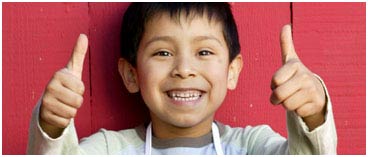| | 

Look for it every day on Noggin
Join the culinary adventures of Luis, a young chef from down under with an infectious enthusiasm for food. In his bow-tied apron, our adorable host guides us through the cooking process from start to finish, reminding us how to be safe and, above all, to have fun! In Luis’ world, the kitchen becomes a learning playground, where kids can take ownership of the cooking process and develop confidence in their own abilities. Look for these shorts every day during NOGGIN's Snack Time series.


Food is always of high interest to preschoolers. As young Luis turns raw ingredients into healthy treats, he not only sustains that interest, but calls upon a multidisciplinary range of knowledge and attitudes. Cooking for Kids with Luis folds learning objectives from physical science, technology. mathematics and the social sciences into a classic concrete and familiar context. Luis’ kitchen adventures also support children’s developing sense of healthy, appropriate foods.
Cooking for Kids with Luis supports the following objectives from the Physical Science; Technology; Mathematics; Social Sciences; and Health, Physical Education, and Safety sections of NOGGIN’s Curricular Framework for Connected Learning:
- Become familiar with physical materials and objects.
- Benchmarks supported include:
- Describe objects.
- Manipulate objects and relate changes to actions.
- Explore the concept that materials can exist in several states, and the concept that these states can change.
- A benchmark supported in particular is:
- Describe physical characteristics of materials.
- Explore properties of liquids and solids.
- A benchmark supported in particular is:
- Observe and discuss effects of heat (e.g., sidewalk on sunny day) and cold (e.g., refrigerator, freezer).
- Explore the concept of chemical (i.e., irreversible) changes in materials.
- Benchmarks supported include:
- Mix materials to make different substances.
- Observe and discuss changes when water is added.
- Take part in cooking and observe/ describe what happens when liquid, heat, or cold is added.
- Experiment with dissolving materials in liquid.
- Name human-made objects
- Benchmarks supported include:
- Begin to recognize that some objects are made by humans.
- Describe objects in terms of "what they’re made of" and "how they’re made."
- Become familiar with basic, everyday technologies
- A benchmark supported in particular is:
- Explore workings of common objects and devices that employ basic technology (e.g., buttons, zippers, erasers).
- Develop concepts of measurement
- Benchmarks supported include:
- Explore the process of measuring.
- Develop vocabulary of measurement (e.g., more/less, tall/short, heavy/light, wide/narrow).
- Compare relative characteristics of objects (e.g., heavier/lighter, longer/shorter, less/more).
- Use nonstandard measuring tools (e.g., hand, piece of string).
- Begin to measure for balance, capacity, temperature, time, etc.
- Demonstrate positive attitudes toward learning about the social world
- Benchmarks supported include:
- Demonstrate curiosity about a broad diversity of people and places.
- Enjoy aspects of diverse cultures (e.g., stories, music, food).
- Understand role of consumer
- Benchmarks supported include:
- Engage in dramatic play as consumer.
- Make purchases at store.
- Understand role of producer
- Benchmarks supported include:
- Talk about family members’ work and services encountered in immediate environment.
- Produce art and other creative work.
Health, Physical Education, and Safety:
- Cultivate healthful eating habits
- Benchmarks supported include:
- Try new foods.
- Eat balanced diet.
- Understand food is necessary for health and growth.
- Follow good safety practices at home and school
- A benchmark supported in particular is:
- Stay away from things that are sharp or hot, and from unknown liquids.
|
|
|
